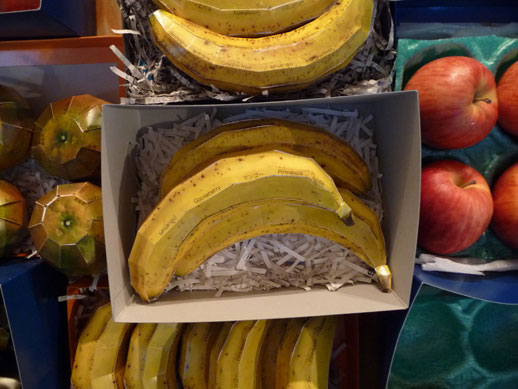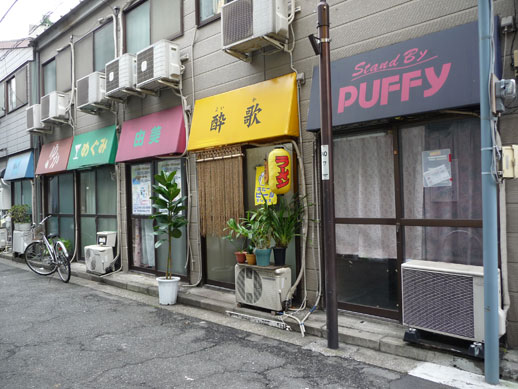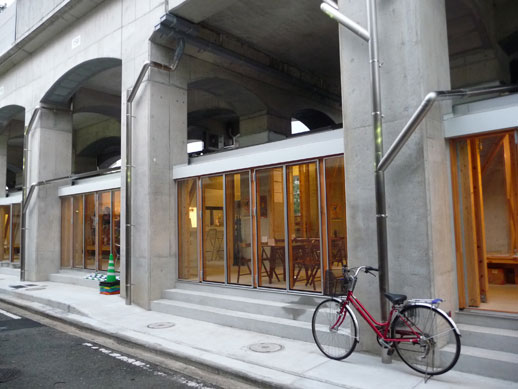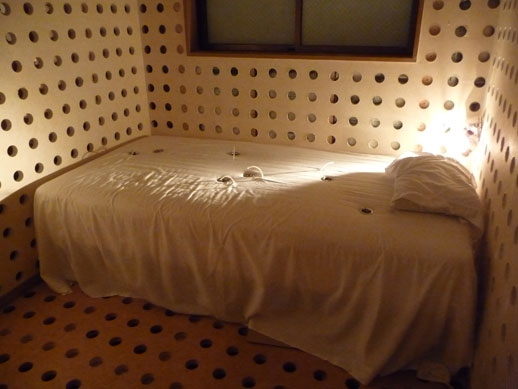Under the Tracks: The Koganecho Bazaar
Strung out along the Ooka River, the Koganecho Bazaar is a multi-venue art fair on the water’s edge of what was, and might still be, Yokohama’s most notorious red light district. The main venues are two new art spaces, the Hinode and Koganecho Studios, set up in the hollows under the Keihin Railway tracks. The bazaar also incorporates cafés, boutiques, workshop spaces, both fixed and temporary, with special events and performances scattered around the neighborhood. Compared to the nearby Triennale’s cubicle set-up, the Koganecho Bazaar offers visitors an attractive, interactive experience with the city of Yokohama. With both fairs, Yokohama is consolidating its reputation as an art lover’s playground. Armed with this idea, a map of the venues, and a pre-existing affinity for start-up community-based art fairs, I set out on a sunny weekday to check out Koganecho.

I had an absolutely delightful afternoon. I chatted with several of the artists, present and pleasantly communicative about their own exhibitions. A few installations had a hands-on element and I even made a paper-craft banana with Thai artist Wit Pimkanchanapong, which he let me exchange for a real one. Snacking on my banana, I explored the clever catwalks snaking above the Hinode Studio, designed by Yoshihiko Iida and graduate students from the University of Yokohama. I browsed Food Landscape, a select shop that functions as a “best-of” for locally sold goods and edibles. When I felt like a break I sipped a latte at a café sponsored by Ginza Hungarian restaurant Tokaj, where I flipped through Hungarian children’s books and the armful of enticing event flyers I picked up at the information center. All of this ended with a Spanish omelette and a glass of house red wine at a nearby restaurant that had landed itself on the event map.
On the other hand, the Koganecho Bazaar does not put forward a clear aim, which is problematic. Given the hyped-up neighborhood setting, I expected a showcase of artists living and working in the community. In fact, only a few are, and the rest come from a diverse background that spans borders. Nor is there a theme or concept to unite the loose assemblage of artists. I wondered, as I did after visiting the neighboring Triennale, “Why these artists, why here?”

Moreover, the “here,” that is the location itself, is complicated in way not reflected in the bazaar. Government crackdowns have turned Koganecho’s streets, lined with old-fashioned, two-storey wooden brothels, into a ghost town. The few local residents with whom I spoke speculated that the mafia-controlled prostitution had only moved underground and that years, if not decades, would be necessary to reform the area. While I make no claims that art must invoke the political, given the politically charged nature of the neighborhood, it is surprising that so few of the artists address the controversy and challenges that the location presents. Instead, the works are, in general, notably non-confrontational.

The motivation of the event, which is co-organized by the city of Yokohama seems to be a public presentation of the new studio spaces and the repackaging of Koganecho’s image as an artsy, creative neighborhood, probably as a way to draw visitors to an economically stagnant area. Keihin Railway, who ostensibly owns the land under the tracks where the studios were created, is among the list of corporate sponsors. These points go a long way towards explaining the noticeable smell of fresh wood, colorful, well-crafted bilingual materials, and lack of controversy; this is not a grass-roots event, but closer resembles something that could be called art-washing.
Grievances aired, I think that, taken together, the contradicting layers and players actually make the whole thing more interesting. There are also a handful of installations, particularly those from local artists, that are worth the visit. Takayoshi Kitagoma, for example, takes as his medium a small house representative of those in Koganecho, and if it wasn’t originally a brothel, it has been done up to resemble one now. With partitions of perforated plywood, numerous beds fitted with white mattress covers and sink drains, and lights that glow and fade on repetition, the artist manifests a sense of the sterility and perfunctory-ness of sex in the only partly visible world of the mizu shobai.

The Portrait Studio, run by local photographer Takashi Arai, is also noteworthy. This active installation intends to document and display the event as a work in progress, and the first installment includes images of the artists setting up their works. The Portrait Studio will also hold open studio days for visitors to have their pictures taken by participating photographers, who include Shigeo Anzai. Thanks to the multiplicity of photography, these images will serve as both an archive of the event and a take home souvenir of a day trip to Koganecho.
Koganecho, as it appeared to this first-time visitor, is very much indicative of a moment in time, both of the recent government “clean-up” efforts and the power of art as a clean-up strategy. It is also very much a shitamachi neighborhood: one whose taboo industry has kept it particularly isolated and is, now, accelerating its transformation into something else. To capture and reflect upon this intersection of time and space is a powerful possibility for an exhibition like Koganecho Bazaar. Had this been the aim of the event as a whole I would have considered it a success. However, with only a few artists taking on this challenge, this potential remained only partially realized and, moreover, those isolated sparks were too easily consumed by the overwhelming feel-good atmosphere that characterized the event.
Rebecca Milner
Rebecca Milner



